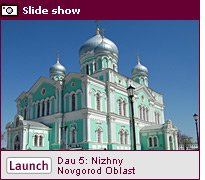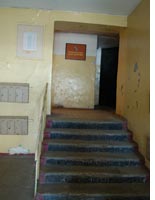A Nuclear Family Vacation in Russia
"The new Sarov Technopark at Avangard is a successful example of how Russian nuclear weapons scientists and plants of the Cold War era can join private industry in the 21st century," said Richardson at the groundbreaking ceremony.
It seemed like a good idea at the time, when Sept. 11 was another day of the year, WMD was not part of the popular lexicon, and Russia's new president, Vladimir Putin, seemed a promising partner for the United States. Richardson said the U.S. government planned to invest at least $4.5 million in similar projects the following year.
Sarov, formerly known as Arzamas-16, would remain closed to ensure security for sensitive nuclear materials, but an open territory just outside the fence would house the technopark. There, Russian scientists could work in relative freedom with their Western counterparts. The United States helped pay for it, Russia promoted it, and six years later, we were curious to see how the experiment was going.
After being denied permission to go inside the closed city (we had asked to visit the museum, a seemingly innocuous request), we sought an invite to the technopark. While the area was described in public-relations materials as an "open access" zone, it took many faxes, formal letters, and phone calls before we finally won permission. Open access, we learned, does not necessarily mean accessible.
Sarov is more than 250 miles from Moscow. We traveled overnight by train to Nizhny Novgorod, known as Gorky in Soviet times and famous as the residence-in-exile of Andrei Sakharov, Soviet dissident and father of the Soviet Union's hydrogen bomb. In the 1980s, Sakharov lived in a flat on Gagarin Street with his wife, Yelena Bonner, and their "housekeeper," a KGB employee who would let security agents in the window to rummage through the apartment.
In Nizhny Novgorod, we hired a Volga taxi that reeked of benzene for the drive to Diveyevo, the village closest to Sarov. Once in the village, we were to use a local pay phone (not our mobile phone) to ring the technopark staff, who would provide further instructions. We weren't quite sure what would happen at that point, though something involving blindfolds seemed plausible. Just a few miles away from our destination, we called the technopark to let them we were running on schedule; minutes later, as we reached the outskirts of Diveyevo, we received a frantic cell-phone call from our assistant in Moscow. The meeting had been canceled.
"But we just spoke to them!" we protested.
We immediately rang the technopark, and a brusque secretary picked up the phone. Every single staff member at the technopark had been summoned to Moscow at the last minute, she explained. No one, except her, was in the building.
Was anyone reachable by mobile? No, they all had their phones turned off. Could we just stop by to see the place? I'm not authorized, the secretary said. Was there was at least some literature available? Again, the answer was no. Someone would contact us in Moscow, and that was the end of the call. We were just outside the gates of Sarov.
We were dumbstruck. Why invite foreigners to travel 10 hours by train and car (not to mention the trip to Moscow), only to cancel their visit? We accepted that, as journalists, we wouldn't be allowed inside the closed cities, but to be turned away from an approved visit to an allegedly open facility seemed absurd.
Of course, it wasn't completely unexpected. Viktor Mikhailov, a former Russian minister of atomic energy who spent his scientific career at Arzamas-16, had warned us that working with closed cities had become "much more complicated" in recent years. "The security services are really tightening the screws," he said.
Part of the explanation lies in the culture of security around Russia's closed cities. It's more than just building fences: The idea is to keep scientists, the best source of WMD expertise, from contact with the outside world.
Elizabeth Turpen, a former congressional staffer, worked on the issue of nuclear proliferation for years, and she recalled the anarchic days of the 1990s, when destitute Russian scientists were said to be job-hunting in places like Iran, Iraq, and North Korea. Keeping Russia's closed cities fenced off was the least bad option, she decided. "In 1999, I came to the conclusion the fences are our friend, because things were so bad," she said.
Is that still true today? While Russia and the United States have cooperated on a lot of initiatives to prevent the spread of nuclear technology, not even the most Pollyannaish diplomat would describe the relationship as warm and friendly. The reason, according to Rep. Curt Weldon, R-Pa., is that the U.S. foreign-policy establishment keeps dropping the ball.
"The Russians try repeatedly to reach out to us and repeatedly are rebuffed by us," he said. "Putin feels rebuffed more and more, so it's natural for him to fall back on the KGB crowd."
Weldon has taken dozens of trips to Russia and says successive administrations have ignored his advice. Whatever the case, cooperation with Sarov has been halting at best. The city is still closed, and the technopark is hardly a magnet for free enterprise. Perhaps the only place in the region that has successfully opened to the outside world is the Russian Orthodox convent in Diveyevo.
We stopped in Diveyevo, nauseated and exhausted after our two-hour ride in the Volga taxi. St. Seraphim of Sarov, a Russian monk and mystic occasionally compared to St. Francis of Assisi, was spiritual leader here in the early 19th century; the nuclear city of Arzamas-16 was built on the grounds of the Sarov monastery. The Soviets shuttered both the convent and neighboring monastery in the 1920s.
Nadezhda, a local guide, took us on a tour of the convent. There wasn't a hint of bitterness in her voice, even as she described how the secret police had used the historic Preobrazhensky Cathedral as an indoor target range. The buildings were now all under renovation, the churches were restored, and devout young couples now strolled the grounds.
In the convent, we forgot our frustration over the failed visit to the "open" technopark and marveled instead at how history can right itself. For a moment, we felt at peace.
But the serenity was short-lived. Back in Moscow, we met one of the technopark's managers in a chance encounter in the offices of the Closed Nuclear Cities Partnership, a U.K.-Russian project. When we described our road trip to one of the directors of the fund, he suddenly remembered that "Elena from Sarov" was in the office that day. A few minutes later, he returned to introduce us to Elena Diyakova, who clearly was not pleased to meet us. She shot us an icy look.
"Oh yes, I heard you came all that way," she said unapologetically, handing us a brochure.
It was a flimsy pamphlet for the technopark, written in stilted English and quoting Putin saying, "Such technoparks is of great social and economic importance." According to the brochure, construction started on Building 2 in 2005, five years after Richardson's visit. They still weren't open for business.
What had happened? Who blocked our visits, and why? Diyakova offered no clue but said to call again next time. Our friend from the conversion fund merely smiled. "You'll never know the truth," he whispered as he escorted her out the door.


